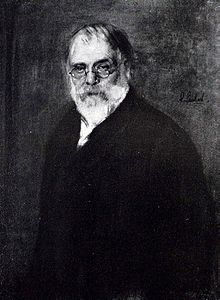Alois Hauser the Elder
Alois Hauser (born February 17, 1831 in Burladingen , died March 7, 1909 in Munich ) was a German restorer , court painter and curator .
Life
Alois Hauser was born in Burladingen in the Principality of Hohenzollern-Hechingen in 1831 as the son of a potter . At the age of 14, Alois began an apprenticeship with the decorative painter Kaspar Lieb (1803–1864) in Hettingen . Through the mediation of the businessman Anton Carry (1797–1860), who had looked after the picture gallery in Hechingen since 1845 , Alois Hauser was able to continue his training from 1847 to 1854 in Augsburg with the painter and restorer Anton Deschler (1816–1881) and the local art school in the polytechnic visit, which was housed with the State Gallery founded in 1835 in the former St. Catherine's Monastery . Deschler was a student of long-time gallery inspector Andreas Eigner .
Presumably through the mediation of Anton Carry, Hauser came into contact with his former sovereign Konstantin von Hohenzollern-Hechingen , who had ceded his principality to the King of Prussia after the revolution of 1848/1849 and has since resided in Löwenberg in Silesia . Hauser took over the care of the prince's collection of paintings, which was transferred from Hechingen to Löwenberg at the beginning of the 1850s, from Carry, who appointed him court painter and gallery curator in 1855. Hauser also worked as a painter. However, he also worked for an art dealer in Bamberg , which gave him significantly more lucrative commissions, so that Hauser moved to Upper Franconia in 1861.
In Bamberg, Hauser was able to gain a good reputation as a restorer in a few years, who was increasingly entrusted with tasks by public collections, in particular by the Germanic Museum in Nuremberg, founded in 1852 . In Bamberg itself, Hauser had worked at the art institute founded by Carl Schmidt (1791–1874) from 1865; In 1869 he was appointed curator of the city's collection of paintings. His growing reputation as a restorer led Hauser to Munich in 1875 , where he took over the conservation of the Alte Pinakothek . In 1885 he was appointed curator and in 1889 professor.
Hauser was a capacity in his time as a restorer. His expertise and technical ability made him one of the most sought-after painting restorers of the early days. The prominent works in the Alte Pinakothek that he restored include Dürer's Paumgartner Altar , Rubens' Last Judgment and van Dyck's Susanna in the Bath . His best-known assignment, however, was the restoration of the Darmstadt Madonna in 1887, the result of which was honored with a separate exhibition. Hauser belonged to a new generation of restorers who, unlike the older painter restorers, dealt with the analysis of historical painting techniques in order to make interventions in the substance of the picture calculable. In Munich, too, Hauser used his studio to train young people who later worked at large museums themselves: including his son Alois Hauser jr. (1857–1919), who became chief restorer of the Berlin Gemäldegalerie in 1887 , or Otto Vermehren , who later became director of the restoration workshops at the Uffizi in Florence.
When Hauser died in Munich in 1909 and was buried in Schwabing, the mourners were large - and they were convinced that Hauser would lose a role model for his profession. For the grave speaker Franz von Reber , director of the Bavarian State Collections, Hauser was "not just the best one, but the best in his field in his time".
literature
- Burger, Friedrich Richard: Open letter to Professor Alois Hauser, I. Conservator at the Alte Pinakothek in Munich , Munich 1906 ( digital )
- Holland, Hyacinth : Hauser, Alois . In: Biographisches Jahrbuch und Deutscher Nekrolog 14 (1912), pp. 164–167 ( digital )
- Senn, Ernst: On the Hohenzollern image. Von Lenbach: Professor Alois Hauser 1831–1909 . In Hohenzollerische Jahreshefte 7 (1940), pp. 110-113
- Mandt, Petra: Alois Hauser d. J. (1857–1919) and his manuscript "On the Restoration of Paintings" . In: Journal for Art Technology and Conservation 9 (1995), Issue 2, pp. 215-231
Individual evidence
- ↑ After the death of Pauline von Sagan , the mother of Prince Constantine , her art possessions came from Vienna and Silesia to Hechingen and were made accessible to the public there in the New Palace for a few years. Cf. Eglers, Ludwig: Chronik der Stadt Hechingen , Vol. 1, Hechingen 1980, pp. 236f.
- ↑ The acquaintance with Franz von Lenbach , who portrayed Hauser in 1890 and 1900, is likely to go back to their school days at the Polytechnic.
- ^ After Holland 1912, p. 164.
- ↑ In 1896 Hauser published his "Instructions for the Technique of Oil Painting" ( digital )
- ↑ Holland 1912, p. 167
| personal data | |
|---|---|
| SURNAME | Hauser, Alois the Elder |
| ALTERNATIVE NAMES | Hauser, Alois |
| BRIEF DESCRIPTION | German restorer, court painter and conservator |
| DATE OF BIRTH | February 17, 1831 |
| PLACE OF BIRTH | Burladingen |
| DATE OF DEATH | March 7, 1909 |
| Place of death | Munich |
